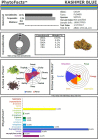The Case for the Entourage Effect and Conventional Breeding of Clinical Cannabis: No "Strain," No Gain
- PMID: 30687364
- PMCID: PMC6334252
- DOI: 10.3389/fpls.2018.01969
The Case for the Entourage Effect and Conventional Breeding of Clinical Cannabis: No "Strain," No Gain
Abstract
The topic of Cannabis curries controversy in every sphere of influence, whether politics, pharmacology, applied therapeutics or even botanical taxonomy. Debate as to the speciation of Cannabis, or a lack thereof, has swirled for more than 250 years. Because all Cannabis types are eminently capable of cross-breeding to produce fertile progeny, it is unlikely that any clear winner will emerge between the "lumpers" vs. "splitters" in this taxonomical debate. This is compounded by the profusion of Cannabis varieties available through the black market and even the developing legal market. While labeled "strains" in common parlance, this term is acceptable with respect to bacteria and viruses, but not among Plantae. Given that such factors as plant height and leaflet width do not distinguish one Cannabis plant from another and similar difficulties in defining terms in Cannabis, the only reasonable solution is to characterize them by their biochemical/pharmacological characteristics. Thus, it is best to refer to Cannabis types as chemical varieties, or "chemovars." The current wave of excitement in Cannabis commerce has translated into a flurry of research on alternative sources, particularly yeasts, and complex systems for laboratory production have emerged, but these presuppose that single compounds are a desirable goal. Rather, the case for Cannabis synergy via the "entourage effect" is currently sufficiently strong as to suggest that one molecule is unlikely to match the therapeutic and even industrial potential of Cannabis itself as a phytochemical factory. The astounding plasticity of the Cannabis genome additionally obviates the need for genetic modification techniques.
Keywords: cannabidiol; cannabinoid; cannabis; genetically modified organism; genomics; hemp; marijuana; tetrahydrocannabinol.
Figures


Similar articles
-
Pharmacological Foundations of Cannabis Chemovars.Planta Med. 2018 Mar;84(4):225-233. doi: 10.1055/s-0043-122240. Epub 2017 Nov 21. Planta Med. 2018. PMID: 29161743
-
The Terroir of Cannabis: Terpene Metabolomics as a Tool to Understand Cannabis sativa Selections.Planta Med. 2019 Jul;85(9-10):781-796. doi: 10.1055/a-0915-2550. Epub 2019 May 16. Planta Med. 2019. PMID: 31096276
-
Cannabis Pharmacology: The Usual Suspects and a Few Promising Leads.Adv Pharmacol. 2017;80:67-134. doi: 10.1016/bs.apha.2017.03.004. Epub 2017 Jun 5. Adv Pharmacol. 2017. PMID: 28826544 Review.
-
Broad-Scale Genetic Diversity of Cannabis for Forensic Applications.PLoS One. 2017 Jan 20;12(1):e0170522. doi: 10.1371/journal.pone.0170522. eCollection 2017. PLoS One. 2017. PMID: 28107530 Free PMC article.
-
Cannabis Phytomolecule 'Entourage': From Domestication to Medical Use.Trends Plant Sci. 2020 Oct;25(10):976-984. doi: 10.1016/j.tplants.2020.04.007. Epub 2020 May 13. Trends Plant Sci. 2020. PMID: 32417167 Review.
Cited by
-
Identification of Anti-Neuroinflammatory Bioactive Compounds in Essential Oils and Aqueous Distillation Residues Obtained from Commercial Varieties of Cannabis sativa L.Int J Mol Sci. 2023 Nov 22;24(23):16601. doi: 10.3390/ijms242316601. Int J Mol Sci. 2023. PMID: 38068924 Free PMC article.
-
Effects of Full-Spectrum Cannabis Oil with a Cannabidiol:Tetrahydrocannabinol 2:1 Ratio on the Mechanisms Involved in Hepatic Steatosis and Oxidative Stress in Rats Fed a Sucrose-Rich Diet.Med Cannabis Cannabinoids. 2023 Nov 15;6(1):170-183. doi: 10.1159/000534610. eCollection 2023 Jan-Dec. Med Cannabis Cannabinoids. 2023. PMID: 38023489 Free PMC article.
-
Δ9-Tetrahydrocannabinol Differentially Alters Cannabidiol Efficacy in Recovery of Phonology and Syntax Following Damage to a Songbird Cortical-Like Brain Region.Cannabis Cannabinoid Res. 2023 Oct;8(5):790-801. doi: 10.1089/can.2022.0073. Epub 2022 Sep 19. Cannabis Cannabinoid Res. 2023. PMID: 36125410 Free PMC article.
-
Tobacco Rattle Virus as a Tool for Rapid Reverse-Genetics Screens and Analysis of Gene Function in Cannabis sativa L.Plants (Basel). 2022 Jan 26;11(3):327. doi: 10.3390/plants11030327. Plants (Basel). 2022. PMID: 35161308 Free PMC article.
-
Dysmenorrhoea: Can Medicinal Cannabis Bring New Hope for a Collective Group of Women Suffering in Pain, Globally?Int J Mol Sci. 2022 Dec 19;23(24):16201. doi: 10.3390/ijms232416201. Int J Mol Sci. 2022. PMID: 36555842 Free PMC article. Review.
References
-
- Anderson L. C. (1980). Leaf variation among Cannabis species from a controlled garden. Bot. Mus. Lealf. Harv. Univ. 28 61–69.
-
- Appendino G., Taglialatela-Scafati O., Minassi A., Pollastro F., Ballero L. M., Maxia A., et al. (2015). Helichrysum italicum: the sleeping giant of Mediterranean herbal medicine. Herbalgram 105 34–45.
-
- Bailey L. H., Bailey E. Z. (1976). Hortus Third: A Concise Dictionary of Plants Cultivated in the United States and Canada. New York, NY: Macmillan.
LinkOut - more resources
Full Text Sources
Other Literature Sources

